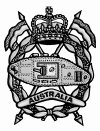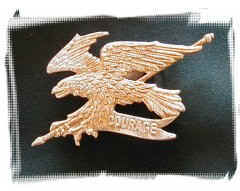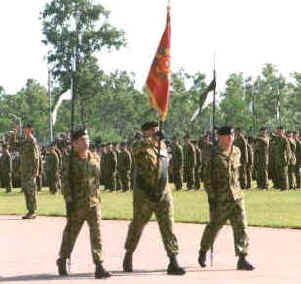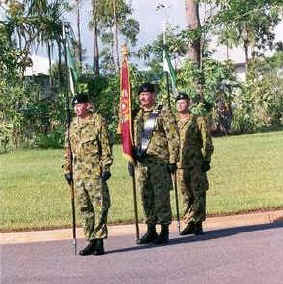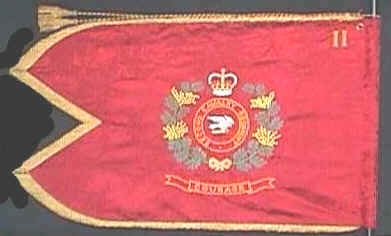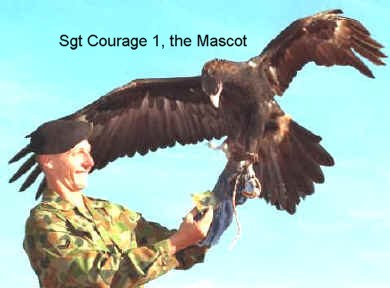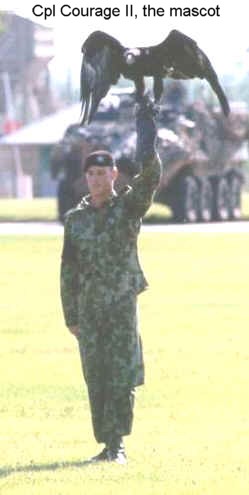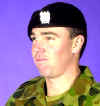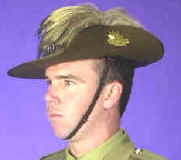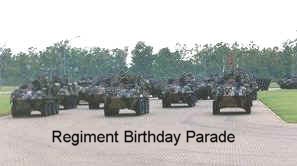 |
|
|
|

|
2 Cavalry Regiment |
|||||||||||||||||||||||||||||||||||||||||||||||||
|
Royal Australian Armoured Corps |
||||||||||||||||||||||||||||||||||||||||||||||||||
|
"COURAGE" |
||||||||||||||||||||||||||||||||||||||||||||||||||
| Regiment Badge |
|
Corps Badge |
||||||||||||||||||||||||||||||||||||||||||||||||
|
As early as 1965 when the title 1st Cavalry
Regiment was adopted, the unit started forming a regimental identity. The
Regimental system and all that it implies are reflected in a number of different
ways. The Regiment, despite being young, has a number of traditions.
Immediately after the name 1st Cavalry Regiment was adopted, a Squadron competition was held to design a distinctive badge for the Regiment. Since the unit was intended largely to carry out the role of reconnaissance ("the eyes of the ADF") a bird of prey seemed the logical emblem. The Australian Wedge Tailed Eagle, with its keenness of sight and its ability to roam over large distances, was finally selected as the model for a badge. A competition was run within the unit and won by the orderly room corporal, Corporal T. C. Burgess. Early in 1967, the 2nd Cavalry Regiment received its new badge, a wedge tailed eagle swooping, carrying a lance bearing the motto "Courage" in its talons.
Regimental Colours The colours of the 2nd Cavalry Regiment are green over white. The Regiment's colours are shown on the pennants carried on lances for ceremonial occasions. (Note that this is only a reference to the colours used on identification pennets and the like and is not to be confused with the Regimental Colours of an infantry unit which are sacred ceremonial flags. In the Cavalry and other horse units that role is taken by the Guidon).Guidon
The Guidons of the RAAC are patterned on
those of the British Army and are only carried by an RAAC Squadron Sergeant
Major (SSM), with an escort of two Senior Non Commissioned Officers (NCO). The
Sovereign personally approves the design of the Guidon and either presents it,
or is represented, at the presentation. The Guidon is rectangular with rounded
swallow tails, is made of crimson silk damask and bears the Regimental crest,
title and motto. These are surrounded by a wreath of wattle leaves under an
Edwardian Crown. The pike is a single length of Ashwood and is topped with a
gilt crest.
The first guidon was held by A Squadron after manufacture, awaiting formal presentation. Presentation was originally planned for early 1971 and initial plans included the movement of B Squadron from Enoggera for the presentation, using A Squadron 3rd Cavalry Regiment to hold ground. The Guidon was to be shared between A and B Squadrons. These plans were made before RHQ was raised. Delays due to the protocols of presentation meant that by the time presentation dates were confirmed considerable changes had occurred to the Regiment, with B Squadron becoming A Squadron 4th Cavalry Regiment, and A Squadron 3rd Cavalry Regiment becoming B Squadron 2nd Cavalry Regiment. The Queen's representative in NSW, the Governor, Sir Roden Cutler, VC, KCMG, KCVO, CBE presented 2nd Cavalry Regiment with its first Guidon on 5 August 1972, at a parade in Holsworthy West. This original Guidon was not saved when the Officers Mess was tragically razed by fire on 4 February 1990. The Regiment's current Guidon was presented to the Regiment on 20 November 1990, on a Regimental Parade on the 1st Brigade Parade Ground, Holsworthy, by Lieutenant General Coates, who was the CGS at the time. Although custom dictates that the Guidon be housed in the Officers Mess, the Regiments Guidon is now lodged in the foyer of RHQ. All members of the Regiment now have the opportunity to see the Guidon. It is customary to salute the Guidon on entering RHQ. MascotCourage 1
On 14 November 1967 the new mascot, Trooper Courage, then six weeks old, was presented to the unit. The first ceremonial activity that Courage took part in was a Beating of the Retreat at Victoria Barracks Sydney in 1969. Courage paraded with the Regiment on nearly every ceremonial occasion since that time including the presentation of the guidon on 5 August 1972, when she won much praise by the then Governor of NSW, Sir Roden Cutler. The highlight of her career was in February 1974 when she took part in the house guard for Her Majesty Queen Elizabeth II. Courage was promoted through the ranks to Sergeant, and became a very tolerant mascot, even attending dinners in the Sergeants Mess. On 2 April 1987 Sergeant Courage died. Her death was commemorated with a memorial service and a special edition of Routine Orders was published. Her record of service is as follows:
Courage II
His service details to date are as follows:
Regimental HonoursMeritorious Unit Service AwardThe 2nd Cavalry Regiment received a Meritorious Unit Service Award from the Government of New South Wales, in recognition of the contribution by the members of the Regiment, in the operations that followed the Northern Suburbs Storm on 21 January 1991. The Award now hangs in RHQ.Darwin Freedom of EntryIn 1992, the 2nd Cavalry Regiment was the first post war combat unit to move to Darwin and was set the task of establishing a rapport with the Darwin community. Subsequently on a parade through the streets on 24 April 1995 the Regiment was granted the Freedom of Entry to the City of Darwin.Lances and Bandoliers
With the general wearing of the slouch hat across the Army, colour patches were reintroduced in the early 1990s. The reintroduced colour patches were based on the designs of the 1st and 2nd AIF colour patches. The design and colour of the 2nd Cavalry Regiment colour patch is based on that of the 4th Light Horse and is light blue over dark blue, divided diagonally from lower to higher, on a rectangular patch. This design was chosen because of links with A Squadron 4th/19th Prince of Wales Light Horse (descended from 4th Light Horse) and is worn on the right side of the puggaree on the slouch hat by all members of the Regiment (including those from other Corps).
Regimental Birthday
This date was chosen to celebrate the Regiment’s birthday, since it was a successful Australian battle and retained links with the Light Horse. A Squadron 4th/19th Prince of Wales Light Horse, who
were later redesignated as A Squadron 2nd Cavalry Regiment, were the recipients
of the 1st Australian Imperial Force 4th Light Horse battle honours, so the
choice of Beersheba Day as the date for the celebration of the Regiment’s
birthday seemed only fitting. The Regiment’s birthday is typically celebrated
every year with a parade and a dining in night. Competitions Competition between troops and squadrons is, and always has been, fierce. The Regiment has many military and sporting competitions. Some, such as the volleyball competition and trophy, date back to A Squadron 3rd Cavalry Regiment whilst others are more recent. The major competitions are the prizes most sought after. Keldie CupThe Keldie Cup is named in honour of the Regiment's first Commanding Officer, Lieutenant Colonel J.D. Keldie, MC, and is the premier military competition of the Regiment. The Keldie Cup was first competed for in 1980 and won by 1 Troop A Squadron. It is competed for annually by the reconnaissance troops. Whilst the competition may have had some variations over the years it is essentially an assessment of troop level reconnaissance tasks. The previous winners of the Keldie Cup are listed below.
|
||||||||||||||||||||||||||||||||||||||||||||||||||
|
|
A.H. Smith TrophyThis trophy is named after the second Commanding Officer and was awarded to the squadron with the best overall small arms results for the year. With the introduction of ASLAV and in recognition of the primacy of AFV Gunnery the Competition was changed to an assessed crew level gunnery competition in 1997. Winners of the A. H. Smith Trophy are shown below.
|
The BRIG Eldridge Challenge TrophyThis is awarded to the champion Squadron, selected on the basis of placing in military and sporting competitions over the year. The trophy is named in honour of the first Honorary Colonel of the Regiment and was first awarded in 1997. The champion squadrons of the Regiment are shown below.
|
Alliances and Affiliations
2nd/6th Cavalry (Commando) Regiment.
This Regiment was formed with the outbreak of World War II and developed a proud tradition during that conflict. The Regiment was the first armoured unit formed at Ingleburn on 3 November 1939 as 6th Australian Division Cavalry. B Squadron made history when it attacked Port Gearnon 12 December 1940 which established it as the first AIF unit action against land forces in the war. The regiment fought against all the nations of the Axis Powers - Italy, Germany, Vichy France and Japan. In doing so it won the following battle honours:
|
|
2nd Cavalry Regiment was chosen by the past members of the 2nd/6th Cavalry (Commando) Regiment to hold and preserve these Battle Honours. On 9 October 1971 at a ceremonial parade the Regiment was presented with a scroll and bronze plaque affiliating the two Regiments. The scroll hangs in RHQ and the plaque is fixed to a large sculptured rock at the base of the Regiments flag pole. The book ‘To The Green Fields Beyond’, written by Shawn O’Leary details the 2nd/6th Regiment's history.
United States 2nd Armoured Cavalry Regiment (2 ACR)
On 21 August 1974 Brigadier General Charles P. Graham (a past Commanding Officer of 2nd Armoured Cavalry Regiment) visited Jordan Lines for the establishment of a ‘Bond of Friendship’ between 2nd Cavalry Regiment and 2nd Armoured Cavalry Regiment. The 2nd Cavalry Regiment presented him with a plaque and a photo album, filled with photographs of his visit and received in turn a plaque from 2nd Armoured Cavalry Regiment which now hangs in RHQ.
